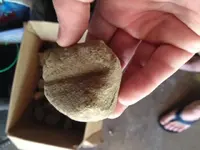You are using an out of date browser. It may not display this or other websites correctly.
You should upgrade or use an alternative browser.
You should upgrade or use an alternative browser.
rock is groovy man
- Thread starter SOHIO
- Start date
larson1951
Silver Member
- Joined
- Apr 8, 2009
- Messages
- 4,962
- Reaction score
- 3,893
- Golden Thread
- 0
- Location
- North Dakota
- Detector(s) used
- tesoro
- Primary Interest:
- Other
yup we have manos here
but they are made from hardstone
i have never heard of them (shaft abraders) being tied together, but i believe you
if you would take a pair of them and use them in the manner that neo's post shows you would quickly see that tying
them together would in some ways be time wasted and take away from the sanding abilities quickly once a few passes were made, get what i mean?
i have tried this and laying one on a surface and applying hand pressure was the way it worked best
but i wasn't there so i can't be sure
now i am gonna post a few more of those on a new thread
i don't think these were tied together however
but they are made from hardstone
i have never heard of them (shaft abraders) being tied together, but i believe you
if you would take a pair of them and use them in the manner that neo's post shows you would quickly see that tying
them together would in some ways be time wasted and take away from the sanding abilities quickly once a few passes were made, get what i mean?
i have tried this and laying one on a surface and applying hand pressure was the way it worked best
but i wasn't there so i can't be sure
now i am gonna post a few more of those on a new thread
i don't think these were tied together however
Last edited:
SOHIO
Bronze Member
- #22
Thread Owner
just checked your new thread no those don't seem to have went together
I don't know why I would think them to be sandstone, the one I had though I remember being of light material and that sandstone you have there looks pretty firm i guess thats why i thought manos could been from more resilient sandstone. the pc i have is the kind of sandstone thats kinda soft and well sandy.
I don't know why I would think them to be sandstone, the one I had though I remember being of light material and that sandstone you have there looks pretty firm i guess thats why i thought manos could been from more resilient sandstone. the pc i have is the kind of sandstone thats kinda soft and well sandy.
pointdlr
Sr. Member
Sohio,
Sometimes I type ahead of my little brain. Yes, the material on nearly every Midwest example I have seen is sandstone. What interests me so much is the grade/grain of the sandstone. I know the local varieties fairly well, and I just don't see the coarse grained sandpaper grade around here. Regardless, the prehistoric people somehow got it, and they knew it was a superior material for making these tools. Before I start rambling again, I did find one in a box of found stone tools this afternoon. Sorry for my foot in the picture.
Regards,
Jon Dickinson
P.S.- I saw in the discussion a theory that they were somehow tied together. I disagree with this theory. Many have multiple grooves from different angles, and are the result of long periods of usage in the tool kit. If my theory is correct, the most efficient types of sandstone were not readily available, and a good piece was to be conserved and coveted. Multiple uses can also be explained by different tools being sharpened on different grooves.
Sometimes I type ahead of my little brain. Yes, the material on nearly every Midwest example I have seen is sandstone. What interests me so much is the grade/grain of the sandstone. I know the local varieties fairly well, and I just don't see the coarse grained sandpaper grade around here. Regardless, the prehistoric people somehow got it, and they knew it was a superior material for making these tools. Before I start rambling again, I did find one in a box of found stone tools this afternoon. Sorry for my foot in the picture.
Regards,
Jon Dickinson
P.S.- I saw in the discussion a theory that they were somehow tied together. I disagree with this theory. Many have multiple grooves from different angles, and are the result of long periods of usage in the tool kit. If my theory is correct, the most efficient types of sandstone were not readily available, and a good piece was to be conserved and coveted. Multiple uses can also be explained by different tools being sharpened on different grooves.
Attachments
SOHIO
Bronze Member
- #24
Thread Owner
wow looks real close to the one I posted. About the tying them together, after reading your last reply I looked at how uneven and lumpy the surface is around the groove. If these were in pairs and placed together I don't see how the grooves on either pc would match nice and neat for a shaft to move through the process and having desired effect on the shaft. Also wouldn't it be easier to just turn the pc as you moved through the task. I understand that the clamping would have not only smoothed a rough shaft but also straighten it. Maybe some used the clamped way at some points throughout history combining two steps and maybe some had separate steps involved in producing a shaft. Maybe they prepared the shaft with a wrench first and then used the sandstone for abrading/smoothing.
Hot zone
Bronze Member
- Joined
- Apr 26, 2012
- Messages
- 1,032
- Reaction score
- 259
- Golden Thread
- 0
- Location
- Clark County Washington
- Detector(s) used
- Tiger Shark 8" coil, vaquero 8"x9" and 5.75" WS, clean sweep coil, Gray ghost deep woods headphones
Whites TRX pointer
, Garrett gold stinger
- Primary Interest:
- All Treasure Hunting
I would have to agree with your theory. I believe there was lots of trading going on especially in the last few hundred years with the arrival of the horse. Upper levels of midden containing more varieties of material for arrowheads comming greater distances. On the lower Columbia River, obsidian from southern Oregon is near the surface, with eastern Oregon agate, jasper and Eastern Washington petrified wood below that to the lowest reaches where more basalt points are found. I theorize an expanded trade route aided by first the river and then horseback from Oregon and California. I have Seen similar shaping tools made from porous volcanic rock that is abundant here and would provide coarse sanding. Good observations and conclusions!Sohio,
Sometimes I type ahead of my little brain. Yes, the material on nearly every Midwest example I have seen is sandstone. What interests me so much is the grade/grain of the sandstone. I know the local varieties fairly well, and I just don't see the coarse grained sandpaper grade around here. Regardless, the prehistoric people somehow got it, and they knew it was a superior material for making these tools. Before I start rambling again, I did find one in a box of found stone tools this afternoon. Sorry for my foot in the picture.
Regards,
Jon Dickinson
P.S.- I saw in the discussion a theory that they were somehow tied together. I disagree with this theory. Many have multiple grooves from different angles, and are the result of long periods of usage in the tool kit. If my theory is correct, the most efficient types of sandstone were not readily available, and a good piece was to be conserved and coveted. Multiple uses can also be explained by different tools being sharpened on different grooves.
Last edited:
Similar threads
- Replies
- 13
- Views
- 997
- Replies
- 8
- Views
- 750
- Suggestion
- Replies
- 18
- Views
- 980
Users who are viewing this thread
Total: 1 (members: 0, guests: 1)
Latest Discussions
-
-
Confederate Gold from the Civil War was Found in a Shocking Place
- Latest: achanceforgold
-
-
-


